European Neighbourhood Policy - East - labour market statistics
Data extracted in January 2023.
Planned article update: April 2024.
Highlights
Between 2011 and 2021 the gender gap in employment rates increased in all European Neighbourhood Policy-East (ENP-East) countries except Azerbaijan.
Georgia and Armenia recorded the highest youth unemployment rates among the European Neighbourhood Policy-East countries in 2021. In Georgia, youth unemployment was 40.5 % for women and 44.3 % for men, while in Armenia it was 33.6 % and 28.0 %, respectively.
Economically active persons aged 20-64, 2011-2021
This article is part of an online publication; it presents information for five European Neighbourhood Policy-East (ENP-East) countries, namely, Armenia, Azerbaijan, Georgia, Moldova and Ukraine, compared with the European Union (EU). Georgia, Moldova and Ukraine also all became enlargement countries in 2022, the European Council giving the three a European perspective and granting Moldova and Ukraine candidate status on 23 June 2022. This article does not contain any data on Belarus, as statistical cooperation with Belarus has been suspended as of March 2022. Data shown for Georgia exclude the regions of Abkhazia and South Ossetia over which Georgia does not exercise control. The data managed by the National Bureau of Statistics of the Republic of Moldova does not include data from Transnistria over which the government of the Republic of Moldova does not exercise control. Since 2014, data for Ukraine generally exclude the illegally annexed Autonomous Republic of Crimea and the City of Sevastopol and the territories which are not under control of the Ukrainian government. The latest statistics in this Statistics Explained article cover the calendar year 2021, before Russia’s invasion of Ukraine. Data on Ukraine for the year 2021 is limited due to exemption under the martial law from mandatory data submission to the State Statistics Service of Ukraine, effective as of 3 March 2022. The article presents a range of labour market indicators such as activity rates, employment rates, an analysis of employment by economic activity and by professional status, and statistics on unemployment.
Full article
Activity rates
The economically active population, also known as the labour force, comprises employed and unemployed persons. The labour force also includes people who were not at work but had a job or business from which they were temporarily absent, for example because of illness, holidays, industrial disputes, education or training. These rates, as well as employment rates, are typically published for the working age population, which is generally considered to be those aged 15-64 years. Data is also published covering only those people aged 20-64 years, in order to take account of the increasing proportion of young people who remain in education.
Figure 1 shows the proportion of the population aged 20-64 that was economically active over the period 2011-2021. Figure 2 compares data for 2011 and 2021, disaggregated to show the activity rates for men and women. Since some of the ENP-East countries’ data on the labour force is compiled using definitions that differ from EU standards, it is generally more useful to compare country data over time, rather than compare between countries.
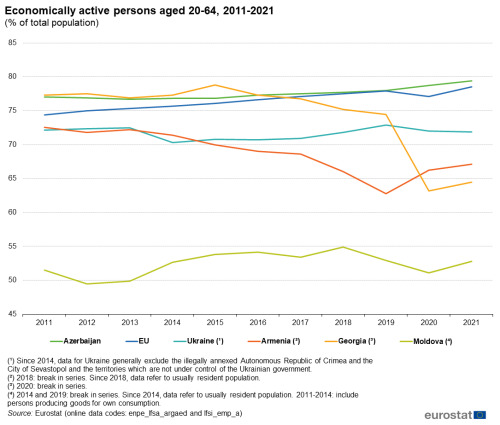
(% of total population)
Source: Eurostat (lfsi_emp_a) and (enpe_lfsa_argaed)
Over the period 2011-2021, the economically active population in Azerbaijan remained relatively stable. It was recorded at 77.0 % in 2011 and at 79.4 % in 2021. Male activity increased by 2.0 percentage points (pp) over the period to 82.2 % in 2021, while female activity increased by 2.8 pp, to 76.8 %. In consequence, the economic activity gender gap slightly reduced.
The total economically active population of Moldova increased by 1.3 pp during the period 2011-2021 to 52.8 %. Note that there were two breaks in the data series. Whereas male participation grew by 3.9 pp to 57.8 %, female participation decreased by 1.1 pp to 48.1 % in 2021. As a result, the economic activity gender gap in Moldova increased by 5.0 pp from 2011 to 2021. This was the largest increase in the gender gap among the ENP-East countries. Moldova also recorded by far the lowest economically active population among the ENP-East countries during the period.
Ukraine recorded a marginally declining gender gap over 2011-2021. Whereas male participation was measured at 78.2 % in 2021, 0.7 pp lower than 10 years earlier, female participation, at 66.0 % in 2021, was 0.1 pp higher than in 2011. This resulted in a small decline in total economic participation of 0.2 pp from 2011 to 71.9 % in 2021.
In Armenia, total participation fell by 5.5 pp from 2011 to 67.1 % in 2021. This was the second largest fall in the percentage of economic active persons among the ENP-East countries. A low point of 62.7 % was reached in 2019. A fall in labour market participation is often associated with a rise in unemployment. However, Figure 6 below suggests that this is not the case. Male participation declined by 3.2 pp from 2011 to 80.8 % in 2021, while female participation fell by 7.7 pp to 55.7 %. The economic participation gender gap therefore increased by 4.5 pp to 25.1 %, the largest among the ENP-East countries.
The decline in the total economic activity rate in Georgia from 2011 to 2021 was 12.8 pp, by far the largest among the ENP-East countries. Most of this occurred from 2019 to 2020, when the economic activity rate fell by 11.3 pp, a consequence of the Covid-19 pandemic. During the period from 2011 to 2019, prior to Covid-19, the annual average decline had been 0.5 pp. Female participation in Georgia fell by 13.9 pp over 2011-2021 to 53.4 %, while male participation fell by 12.4 pp to 76.2 %,. This resulted in a small increase in the economic activity gender gap to 22.8 % in 2021, the second largest among the ENP-East countries. There was a break in the data series for Georgia in 2020, so that data may not be fully comparable with previous years.
Female economic activity grew faster than male in the EU over the period 2011-2021: female participation in 2011 was 67.7 % and male 81.2 %, giving a total activity rate of 74.4 %. By 2021, female participation had grown by 5.2 pp to 72.9 % and male by 2.8 % to 84.0 %, for a total of 78.5 %. Correspondingly, the gender gap fell by 2.4 pp.
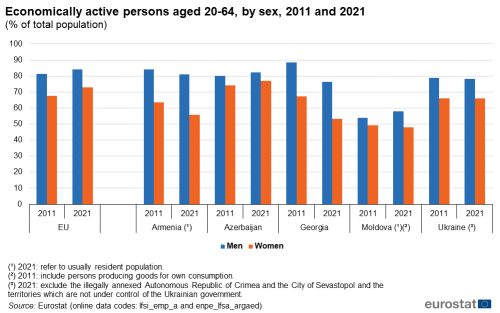
(% of total population)
Source: Eurostat (lfsi_emp_a) and (enpe_lfsa_argaed)
Employment rates
In line with international standards, the EU European Union labour force survey (EU LFS) defines persons in employment as those aged 15 and over, who, during the reference week, performed some work, even for just one hour per week, for pay, profit or family gain. Employment statistics are frequently reported as employment rates to discount the changing size of countries’ populations over time and to facilitate comparisons between countries of different sizes. Employment rates are typically published for people aged 15-64 years, as well as for those aged 20-64 years. The data shown in Figure 3 shows employment rates in 2011 and 2021 by gender for the 20-64 year age group.
In Azerbaijan, male employment grew by 1.2 pp from 2011 to its 2021 value of 78.2 %. Female employment grew faster, by 2.3 pp, to 71.5 %. The gender gap, the difference between male and female employment rates, therefore declined by 1.1 pp to 6.7 % in 2021, the lowest among the ENP-East countries. Employment rates for both sexes, both in 2011 and 2021, were the highest among the ENP-East countries.
In Moldova, male employment increased by 5.8 pp to 55.6n %, while female employment marginally increased by 0.4 pp to 46.9 % in 2021. The gender gap therefore increased by 5.5 pp to 8.7 % in 2021. While this was the largest increase among the ENP-East countries, the 2021 gap was the second smallest.
In Ukraine, male employment declined by 1.3 pp to 70.8 % over 2011-2021, while female employment declined by 2.2 pp to 59.3 %. The gender gap consequently increased by 0.9 pp. In Armenia, male employment declined by 1.5 pp to 68.1 %, while female employment fell by 3.7 pp to 47.0 %. The gender gap therefore increased by 2.2 pp to 21.0 % in 2021, the highest among the ENP-East countries.
In Georgia, male employment fell by 12.2 pp to 58.1 %, while female employment similarly fell by 12.6 pp to 43.5 % over the period 2011-2021. These were by far the largest falls in employment among the ENP-East countries. The gender gap consequently increased marginally over this period by 0.4 pp to 14.6 % in 2021, the second largest among the ENP-East countries.
During the period 2011-2021, EU male employment rate rose by 5.1 pp to 78.5 %. This remained higher than the corresponding rate for women, which rose by 6.8 pp to 67.7 % in 2021. The gender gap consequently fell by 1.7 pp to 10.8 % in 2021.
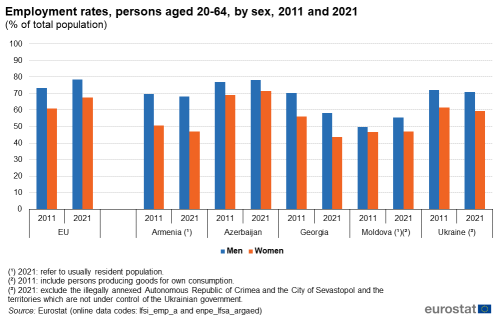
(% of total population)
Source: Eurostat (lfsi_emp_a) and (enpe_lfsa_ergan)
Employment by economic activity
Analysis of employment by economic activity is useful to illustrate changes in the structure of employment over time. The analysis is limited by the fact that the ‘services’ category itself contains a wide variety of activities, such as government, transport services, tourism and business services. The proportion of construction employment typically varies over the economic cycle, with the sector doing well in periods of high growth and often contracting during recessions. Figure 4 shows the structure of employment by economic activity for 2011 and 2021.
In all the ENP-East countries, services accounted for the largest proportion of the workforce in both years 2011 and 2021, except for Georgia in 2011. Over this period, services increased their shares of employment throughout the ENP-East countries. In 2021, services accounted for more than half of all people employed in all the economies of the region except Azerbaijan, where the share was only slightly less than half. Georgia had 62.1 % of employment in the services sector in 2021, the largest share among the ENP-East countries.
A relatively high share of the total workforce was employed in agriculture, forestry and fishing in Georgia, Azerbaijan, Armenia and Moldova. This activity was the second largest employer in each of these countries in 2021. In 2011, the sector had been the largest employer in Georgia. Although there was a break in the time series for Georgia, meaning that the data for the two years may not be comparable, it is worth noting that the sector’s employment share fell by 29.5 pp over 2011-2021. Azerbaijan had the largest share of employment in this activity among the ENP-East countries in 2021, at 36.3 %.
Industrial employment was the second largest employer in Ukraine in 2021 at 18.2 %, although the sector’s share had declined slightly over the period 2011-2021. Nevertheless, Ukraine had the largest share of industrial employment among the ENP-East countries in 2021. The share of industry in employment grew in the other ENP-East countries, although only marginally in Azerbaijan. Although the hydrocarbon sector is very important economically in Azerbaijan, industry as a whole only accounted for 7.4 % of employment in 2021.
Construction employment tends to be highly cyclical. In 2021, construction shares in employment ranged from 7.0 % in Ukraine to 8.8 % in Armenia. In Georgia in 2011, construction employment was not separately identified but instead incorporated into the services sector.
There was a restructuring of the labour markets in Armenia, Georgia and, to a lesser extent, Ukraine between 2011 and 2021. In Ukraine, changes in the data may in part reflect a change in geographical coverage of data. In Georgia, especially, as well as in Armenia, the fall in the share of agriculture, forestry and fishing and the corresponding rise in the employment share of services were large. In both countries, the share of employment in industry also grew to a lesser extent.
Within the EU, services accounted for 71.4 % of persons employed (aged 15 or more) in 2021, substantially higher than any of the ENP-East countries. The share of services within EU employment rose by 3.0 pp from 2011 to 2021.
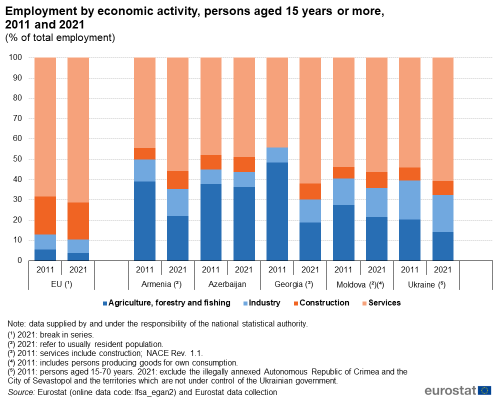
(% of total employment)
Source: Eurostat (lfsa_egan2) and Eurostat data collection
Employment by professional status
This section considers the professional status of workers: the proportions of the employed; and the self-employed and family workers in 2011 and 2021.
The share of self-employment and family work was 65.8 % of the workforce in Azerbaijan in 2021. In Armenia it was 33.2 %; in Georgia, 31.8 %; and in Moldova, 21.8 %. These figures reflect, to some degree, the relative share of agricultural activities in each of these countries, with work spread across numerous small-scale, family-run farms and cooperatives. In contrast, in Ukraine self-employment and family workers represented 16.5 % of the workforce.
Georgia saw a large fall in the share of self-employment and family work of 26 pp over the period 2011-2021, although the break in the time series may mean that the two data points are not comparable. In Moldova, there was a fall of 8 pp. In the other two ENP-East countries for which data are available for both years, Azerbaijan and Ukraine, the decline was -3 pp.
Self-employed and family workers made up 12.0 % of the labour force in the EU in 2021. The share of self-employed and family workers in total employment fell by 2 pp from 2011 to 2021.
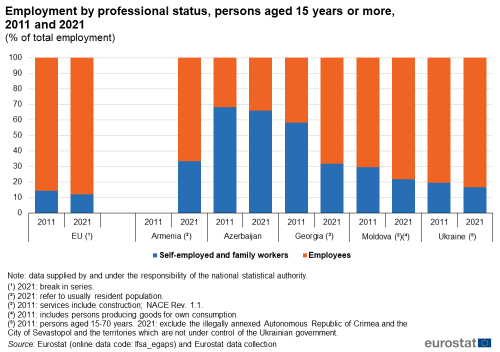
(% of total employment)
Source: Eurostat (lfsa_egaps) and Eurostat data collection
Unemployment rates
Eurostat publishes unemployment statistics based on the definition of unemployment provided by the International Labour Organisation (ILO), for which there are three criteria: being without work, actively seeking work, and being available for work. Therefore, people working only a few hours a week and who wish to work more, known as the underemployed, are excluded from the unemployment figures. In countries that have significant underemployment, the unemployment data will be better understood if they area read in conjunction with employment data. Statistics on part-time work or on total hours worked may also shed light on trends in underemployment.
In general, the unemployment rate begins to rise only some time after an economic downturn has occurred, since some employers seek to retain workers. Once the economy starts to pick up again, employers usually remain cautious about hiring new workers and there may be a lag before the unemployment rate starts to fall. In addition, people who were formerly economically inactive may decide to join or re-join the labour force. These tendencies can be seen in some ENP-East countries in the years after the 2008 global financial and economic crisis. From 2011 onward, there were signs that the labour market was moving to a more balanced position. In the EU, unemployment declined after 2013.
Figure 6 shows data for the ENP-East countries and the EU on unemployment rates as a percentage of the labour force over the period from 2011 to 2021. Comparison of the data between the labour markets of the ENP-East countries may be difficult, either because of breaks in the data series or differences from the standard definition of unemployment.
Unemployment in Armenia was, on average, the highest among the ENP-East countries over the period from 2011 to2021. It generally rose from 2011 to 2019, when the rate was 18.3 %. It marginally declined in 2020 and then fell further in 2021 to 15.5 %.
The average unemployment level was higher in Georgia than other ENP-East countries over the period from 2011 to2021, except for Armenia. It fell each year from 2011 to a low of 11.6 % in 2019. An increase of 6.9 pp left the 2020 unemployment rate at 18.5 %, the period high. A break in the time series may also have had an effect on the 2020 data. The 2021 figure was 20.6 %, higher than in other ENP-East countries.
Ukraine’s unemployment generally rose from 2011 to 2017, then was slightly lower in 2018-2019. There was a change in geographical coverage of data from 2014 and a further break in the data series in 2019. Unemployment was then again higher in 2020 and 2021, when it was 9.8 %.
Azerbaijan recorded the second lowest unemployment rate among the ENP-East countries over the period from 2011 to 2021. From 2011 to 2019, the unemployment rate slightly declined and then remained stable. In 2019, it was 4.8 %. As a consequence of the Covid-19 pandemic, the unemployment rate increased in 2020 by 2.4 pp and led to the highest point of the period, at 7.2 %. The 2021 figure was 6.0 %.
Moldova's unemployment declined from 2011 to 2018. In 2019, there was a break in the time series, which may influenced the large increase in that year, to 5.1 %. The 2020 figure was lower at 3.8 % and lower still in 2021 at 3.2 %. The average unemployment rate was the lowest of the ENP-East countries during 2011-2021.
In some ENP-East countries, it is difficult to see an impact of the global Covid-19 pandemic on the overall unemployment figures. One possible exception is Azerbaijan, which has a large hydrocarbon sector, affected by global energy demand. An economic impact here would have implications for employment throughout the economy. While the break in the data series in 2020 may have affected the increase in unemployment in Georgia, it also appears that the pandemic had an impact on the unemployment rate in that year.
The EU’s unemployment rate rose from 2011 to 11.4 % in 2013. It then declined continuously to 6.7 % in 2019. The 2021 figure was higher, at 7.0 %.
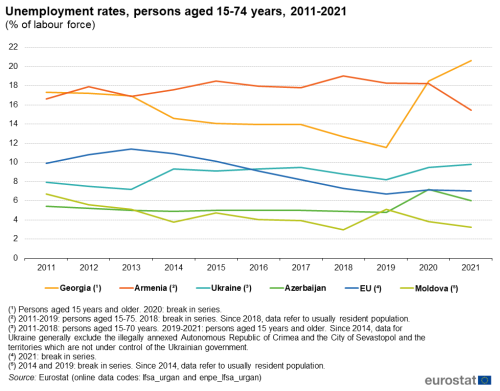
(% of labour force)
Source: Eurostat (lfsa_urgan) and (enpe_lfsa_urgan)
Long-term unemployment, measured as those unemployed for more than 12 months, is often viewed as a key indicator by policymakers. This is because it provides information concerning structural weaknesses in the labour market that may affect social cohesion and economic growth. Data are shown by gender in Table 1.
Moldova had low and declining long-term unemployment rates during the 2011 to 2021 period. Ukraine also showed low long-term unemployment rate. Its 2021 value for men was the second highest of the period and that for women was the period high.
Azerbaijan has had consistent low rates of long-term unemployment for men and somewhat higher rates for women, so that there was an average gender gap of 1.5 %. Long-term unemployment rates for both men and women in Georgia declined considerably from 2011 to 2019, although there was an increase for women in 2012. The figures for 2020 were higher than the previous year and rose again in 2021. While this was a consequence of the Covid-19 pandemic, the 2020 observation may also be affected by a break in the data series.
During the period 2011 to 2021, Armenia had the highest long-term unemployment rates for both women and men among the ENP-East countries. Between 2011 and 2021, the long-term unemployed rate for women decreased by 2.6 pp to 8.7 % and that of men decreased by 0.1 pp to 8.1 %. The long-term unemployment gender gap therefore decreased to a similar value to other ENP-East countries in 2021, from having been the highest in 2011. Note that Armenia’s data had definition changes in 2018.
In the EU, long-term unemployment appears to be more susceptible to cyclical economic changes than overall unemployment. In 2021, the long-term unemployed in the EU made up 2.6 % of the male labour force and 2.9 % of the female labour force.
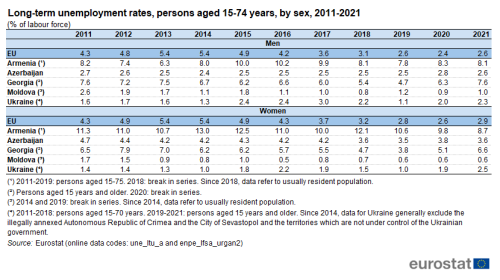
(% of labour force)
Source: Eurostat (une_ltu_a) and (enpe_lfsa_urgan2)
Table 2 provides data on the youth unemployment rate.
Across the ENP-East countries, youth unemployment rates were consistently higher than overall unemployment rates during the period from 2011 to 2021. The highest youth unemployment and the greatest difference from overall unemployment for much of the 2011 to 2021 period occurred in Georgia. In 2021, the youth unemployment rate for women was 40.5 % and for men, 44.3 %. In the same year, the unemployment rate for the whole labour force in Georgia was 20.6 %.
Unemployment in Armenia stood at 28.0 % among young men and 33.6 % among young women in 2021, while the figure for the whole labour force was 15.5 %. For both sexes, these were the second highest rates in 2021 among the ENP-East countries. This data also implies a youth unemployment gender gap of 5.6 %, the largest among the ENP-East countries.
The next highest youth unemployment rates in the ENP-East countries in 2021 occurred in Ukraine, at 18.0 % for men and 20.3 % for women. Overall unemployment in 2021 in Ukraine was 9.8 %.
There was a youth unemployment gender gap of 4.2 % in Azerbaijan, where 12.3 % of young men and 16.5 % of young women were unemployed in 2021, while the unemployment rate for the whole labour market was 6.0 %.
The lowest youth unemployment rates in 2021 among the ENP-East countries were found in Moldova at 9.6 % for young women and 9.0 % for young men.
Youth unemployment for women was higher than for men in 2021 in all ENP-East countries except Georgia, where there was a negative gender gap of 3.8 %.
In 2011, 22.0 % of the EU’s male labour force aged 15 to 24 years and 21.6 % of the corresponding female labour force were unemployed. These figures had fallen to 16.5 % and 16.7 %, respectively by 2021. Nevertheless, youth unemployment in 2021 remained much higher than the average rate recorded for the whole labour force, at 7.0 %.
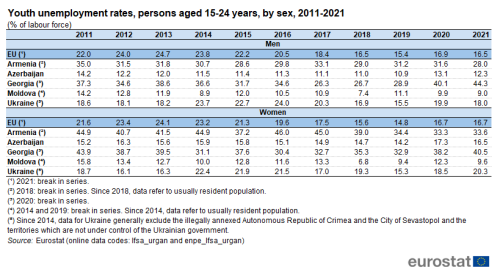
(% of labour force)
Source: Eurostat (lfsa_urgan) and (enpe_lfsa_urgan)
Source data for tables and graphs
Data sources
The data for ENP-East countries are supplied by and under the responsibility of the national statistical authorities of each country on a voluntary basis. The data that are presented in this article result from an annual data collection cycle that has been established by Eurostat. These statistics are available free-of-charge on Eurostat’s website, together with a range of different indicators covering most socio-economic areas.
The main source for European labour force statistics is the European Union labour force survey (EU LFS). This household survey is carried out in all EU Member States in accordance with European legislation; it provides figures at least each quarter.
Tables in this article use the following notation:
| Value in italics | data value is forecast, provisional or estimated and is therefore likely to change; |
| : | not available, confidential or unreliable value. |
Context
Labour market statistics are increasingly used to support policymaking and to provide an opportunity to monitor participation in the labour market. These statistics are used to monitor the effects of events on labour markets, which tend to lag behind changes in economic activity.
Social policymakers often face the challenge of remedying uncertainty in employment and high unemployment by designing ways to increase employment opportunities for specific groups in society, such as the young, those having work in certain economic activities, or those living in low employment regions.
Increasing the number of people in work has been one of the EU’s main policy objectives in recent decades. It has been part of the European employment strategy (EES) from its outset in 1997 and was subsequently incorporated as a target in the Lisbon and Europe 2020 strategies. The employment rate is also included as one of the indicators in the social scoreboard which is used to monitor the implementation of the European Pillar of Social Rights.
The European Commission’s European Social Fund Plus (ESF) 2021-2027 contributes to the EU’s employment, social, education and skills policies, including structural reforms to tackle the socio-economic crisis caused by the COVID-19 pandemic. The Fund will support the EU’s green, digital and resilient recovery from the crisis by driving investment in jobs, skills and services. the ESF+ will promote the horizontal principles of gender equality, respect for fundamental rights, equal opportunities and non-discrimination. ESF+ funding will focus on: • Social inclusion • Education and skills • Employment
In June 2016, the European Commission adopted a Skills Agenda for Europe (COM/2016/0381 final) under the heading ‘Working together to strengthen human capital, employability and competitiveness’. This was intended to ensure that people develop the skills necessary for now and the future, in order to boost employability, competitiveness and growth across the EU. Its objectives are set for 2025.
The open method of coordination (OMC) enables the coordination of the Member States' employment policies towards common objectives for the labour market, without requiring binding European legislative measures. Through the peer reviews and the central role of the Council, it helps spreading good practices among Member States and achieving greater convergence towards the main EU goals. The OMC process for national employment policies is an integral part of the annual European Semester cycle of economic policy coordination.
On 2 July 2021, the European Commission and the EU High Representative for Foreign Affairs and Security Policy presented the Eastern Partnership: a Renewed Agenda for cooperation with the EU’s Eastern partners. This agenda is based on the five long-term objectives, with resilience at its core, as defined for the future of the Eastern Partnership in the Joint Communication Eastern Partnership policy beyond 2020: Reinforcing Resilience – an Eastern Partnership that delivers for all in March 2020. It is further elaborated in the Joint Staff Working Document Recovery, resilience and reform: post 2020 Eastern Partnership priorities. It will be underpinned by an Economic and Investment plan. The Joint Declaration of the Eastern Partnership Summit ‘Recovery, Resilience and Reform’ of 15 December 2021 reaffirms strong commitment to a strategic, ambitious and forward-looking Eastern Partnership.
In cooperation with its ENP partners, Eurostat has the responsibility ‘to promote and implement the use of European and internationally recognised standards and methodology for the production of statistics, necessary for developing and monitoring policy achievements in all policy areas’. Eurostat undertakes the task of coordinating EU efforts to increase the statistical capacity of the ENP countries. Additional information on the policy context of the ENP is provided here.
Direct access to
- All articles on non-EU countries
- European Neighbourhood Policy countries — statistical overview — online publication
- Statistical cooperation — online publication
- All articles on the labour market
Books
Factsheets
Leaflets
- Basic figures on the European Neighbourhood Policy — East countries — 2020 edition
- Basic figures on the European Neighbourhood Policy — East countries — 2019 edition
- Basic figures on the European Neighbourhood Policy — East countries — 2018 edition
- Basic figures on the European Neighbourhood Policy — East countries — 2016 edition
- Basic figures on the European Neighbourhood Policy — East countries — 2015 edition
- Basic figures on the European Neighbourhood Policy — East countries — 2014 edition
- International trade for the European Neighbourhood Policy — East countries — 2016 edition
- European Neighbourhood Policy-East countries — Statistics on living conditions — 2015 edition
- European Neighbourhood Policy — East countries — Key economic statistics — 2014 edition
- European Neighbourhood Policy — East countries — Labour market statistics — 2014 edition
- European Neighbourhood Policy — East countries — Youth statistics — 2014 edition
- Population and social conditions (enpe_pop)
- Labour market (enpe_labour)
- Active population (enpe_lfsa_act)
- Employment (enpe_lfsa_emp)
- Unemployment (enpe_lfsa_unemp)
- Labour market (enpe_labour)
- LFS main indicators (lfsi)
- Employment and activity - LFS adjusted series (lfsi_emp)
- Unemployment - LFS adjusted series (une)
- LFS series - detailed annual survey results (lfsa)
- Eastern European Neighbourhood Policy countries (ENP-East) (ESMS metadata file — enpe_esms)
- LFS main indicators (ESMS metadata file — lfsi_esms)
- LFS series - detailed annual survey results (ESMS metadata file — lfsa_esms)
- European External Action Service — European Neighbourhood Policy
- Directorate-General for Employment, Social Affairs and Inclusion
- Joint Communication JOIN(2020) 7 final: Eastern Partnership policy beyond 2020: Reinforcing Resilience - an Eastern Partnership that delivers for all (18 March 2020)
- Joint Staff Working Document SWD(2021) 186 final: Recovery, resilience and reform: post 2020 Eastern Partnership priorities (2 July 2021)
- Joint Declaration of the Eastern Partnership Summit: ‘Recovery, Resilience and Reform’ (15 December 2021)